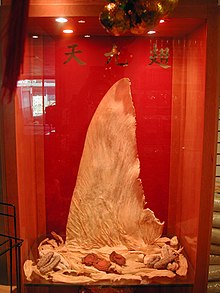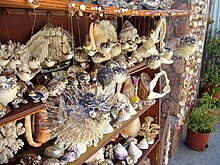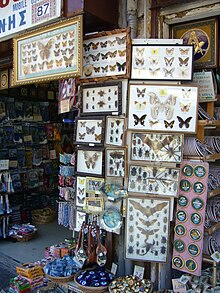Wildlife trade
The wildlife trade includes the legal and illegal trade in wild animals and products made from them. In the case of products, a distinction must be made between those that mean the death of the animal and those that do not. The trade in wild animals can have positive and negative effects on species protection . In many countries the wildlife trade is regulated by national laws for the protection of endangered species . Internationally, it is regulated by the Washington Convention on Species Protection.
Legal trade
In the Washington Convention on the Protection of Species , around 5,600 animals are listed in three different appendices. The trade in these animals and their products is, depending on the attachment and circumstances, commercially prohibited or subject to approval. Appropriate import, export and re-export permits are issued by the relevant national authorities. The UNEP World Conservation Monitoring Center maintains a database on behalf of the Secretariat of the Washington Convention on Endangered Species, in which trade in the listed species is stored; as reported by the member states.
| Taxon | Alive, total | Alive, trade code: wilderness |
|---|---|---|
| Mammals | approx. 15,000 | about 500 |
| Birds | approx. 230,000 | approx. 125,000 |
| Reptiles | approx. 1,000,000 | approx. 150,000 |
| Amphibians | approx. 35,000 | approx. 7,500 |
| fishes | approx. 230,000 | approx. 40,000 |
| Invertebrates without corals | approx. 375,000 | approx. 25,000 |
| Corals | approx. 1,250,000 | approx. 1,000,000 |
Apart from living individuals, hides (mammals, reptiles) and meat are mainly traded internationally. In the period from 2009 to 2013 the most important import regions for living individuals are the USA , China , the European Union and South-East Asia. This is only different for birds, where the main importers are Mexico and the United Arab Emirates . Exact data are not available for international trade in wild animals not listed in CITES. However, this trade can be regulated by national regulations. In many countries, the production of food or clothing from wild animals is regulated by hunting and fishing laws and is subject to the possession of appropriate licenses. Apart from customs and quarantine regulations, trade is then often not subject to any further authorization requirements. The global fisheries caught 92 million tonnes of fishery products in 2006, with 81.9 million tonnes being caught in seas and the remainder being caught in rivers and lakes.
Illegal trafficking
The illegal trade in wildlife is a problem and can pose a serious threat to endangered and endangered species . Illegal and prohibited wildlife trafficking includes pets kept as pets , game trophies , fashion items , works of art , ingredients for traditional medicine and meat from wild animals for human consumption. An illegal trade in wild animals occurs when the import violates the Washington Convention on the Protection of Species , national quarantine laws and other laws that regulate the trade in certain animals or products (e.g. snake liquor ). The relationships between wealth , poverty, and participation in the wildlife trade are complex: the people involved in the trade are not necessarily poor, and the poor who are involved do not reap most of the monetary value of the trade. In 2014, it was estimated that wildlife trafficking (plants and animals) was worth between US $ 7 billion and US $ 23 billion annually. This makes the illegal trade in wild animals one of the five most profitable illegal economic systems in the world .
European Union
The European Union is, according to Europol one of the most important markets for illegally traded species both as a place of origin as well as a market. For the pet market, the European Union is an important sales market in the illegal trade. The European Union is an important place of origin for rare birds, corals and turtles, as well as stolen rhinoceros horn, which is mainly smuggled into China. According to Europol, despite the current crisis, demand in the EU is still significantly higher than the available supply. In the meantime, there has also been a lucrative illegal trade in glass eels from Europe to Asia.
Asia
A significant part of the international illegal wildlife trade takes place in Asia , where the need for certain animal parts for use in traditional Asian medicine , for human consumption and as a symbol of prosperity determines the demand. In Southeast Asia , demand is tending to increase, in part due to the economic boom in the region and the affluence that comes with it. But Southeast Asia is also the origin of products made from wild animals.


China is an important market for the illegal trade in turtles, ivory , tiger products , pangolins and many other species. India and Nepal are the origin and transit point for the trade in body parts of tigers , rhinos , leopards , snow leopards , otters and musk deer , which are used in traditional Chinese medicine and as decoration. The traders use land routes via Sikkim , Ladakh and Tibet because borders are porous and customs clearance is negligent. In Thailand , the Chatuchak Market in Bangkok is an important hub for the sale of freshwater turtles and tortoises as pets . Most of the species of illegal origin that were observed during investigations in 2006 and 2007 or that were confiscated in recent years were not native to Thailand, but came from Indonesia, Indochina , Madagascar , Congo , Uganda , Kazakhstan , Lebanon , Barbados and Venezuela .
In Vietnam , 181,670 individuals were confiscated from 1996 to March 2007 and 14,758 cases were detected and prosecuted involving hunting and wildlife trafficking violations. The expansion of markets and increases in prices have contributed significantly to the development of the wildlife trade, which is the main factor behind the marked decline in populations of some species, such as elephants , pangolins (the Manis subgenus) , amphibians , reptiles , orchids and agarwood .
America
The USA is also an important importer of wild animals and their products, and a large illegal market for wild animals as pets . From 2001 to 2005 more than 11,000 copies, i.e. H. Live animals and wildlife-made products from birds , reptiles , sea turtles , corals and mammals were confiscated in shipments from Costa Rica , El Salvador , Guatemala , Honduras , Nicaragua and the Dominican Republic . Animals from the rainforest of the Amazon are smuggled by the same route to the United States as drugs.
Wildlife trade and conservation
Wildlife trade can be a problem for conservation, especially when it comes to illegal trade and when species are endemic to a small area or populations are small. An example of this is the salamander Neurergus kaiseri , which is now listed on Appendix A of the Washington Convention . But also more widespread species can, e.g. Threatened by hunting, for example, like Gazella saudiya which was declared extinct in 2008. The trade in wild animals, if used sustainably, can also be positive for a species. The screw goat was threatened, among other things, by poaching because of its meat and horns; In 1994 there were only 700 animals left in Pakistan. Since 1992 all subspecies have been listed in Appendix I of CITES and in 1998 a program was initiated within the convention that allows strictly regulated trophy hunting. This program is implemented and controlled by local village communities and the money generated goes into the protection of the species and the village communities. By 2010 it had generated US $ 2 million and the population in Pakistan has increased back to 4,000 animals. In 2015 the species was downgraded by the IUCN from “Endangered” to “Near Threatened”. Vicugna vicugna and Strombus gigas are other examples where the wildlife trade has contributed to the conservation of the species .
Individual evidence
- ↑ CITES How CITES works , cites.org, accessed November 26, 2015
- ↑ UNEP World Conservation Monitoring Center Species Database ( Memento of the original from April 12, 2011 in the Internet Archive ) Info: The archive link has been inserted automatically and has not yet been checked. Please check the original and archive link according to the instructions and then remove this notice. unep-wcmc.org, accessed November 26, 2015
- ↑ a b CITES trade data dashboard dashboards.cites.org, accessed November 26, 2015
- ^ The State of World Fisheries and Aquaculture. FAO Fisheries and Aquaculture Department, Rome, 2009 The State of World Fisheries and Aquaculture ( page no longer available , search in web archives ) Info: The link was automatically marked as broken. Please check the link according to the instructions and then remove this notice. ftp.fao.org, accessed November 27, 2015.
- ↑ Nowell, K., Jackson, P. (1996) Wild Cats: status survey and conservation action plan . IUCN / SSC Cat Specialist Group, Gland, Switzerland.
- ↑ a b Wyler, LS, Sheikh, PA (2008) International Illegal Trade in Wildlife: Threats and US Policy (PDF; 758 kB). Congressional Research Service, The Library of Congress, Washington DC, August 22, 2008, accessed November 26, 2015
- ↑ name = "traffic2008"> TRAFFIC (2008) What's Driving the Wildlife Trade? A Review of Expert Opinion on Economic and Social Drivers of the Wildlife Trade and Trade Control Efforts in Cambodia, Indonesia, Lao PDR and Vietnam (PDF; 3.2 MB). East Asia and Pacific Region Sustainable Development Discussion Papers. East Asia and Pacific Region Sustainable Development Department, World Bank, Washington, DC.
- ↑ Nellemann, C., Henriksen, R., Raxter, P., Ash, N., Mrema, E. (Eds) (2014): The Environmental Crime Crisis - Threats to Sustainable Development from Illegal Exploitation and Trade in Wildlife and Forest Resources. A UNEP Rapid Response Assessment. United Nations Environment Program and GRID-Arendal, Nairobi and Arendal, www.grida.no ISBN 978-82-7701-132-5 , page 23
- ↑ Threat Assessment 2013 - Environmental Crime in the EU, public version europol.europa.eu 2013; Retrieved November 26, 2015
- ↑ The European eel - an endangered species of fish. (PDF; 286 KB) Federal Food Safety and Veterinary Office , February 6, 2019, accessed on December 1, 2019 .
- ↑ a b TRAFFIC (2008) What's Driving the Wildlife Trade? A Review of Expert Opinion on Economic and Social Drivers of the Wildlife Trade and Trade Control Efforts in Cambodia, Indonesia, Lao PDR and Vietnam (PDF; 3.2 MB). East Asia and Pacific Region Sustainable Development Discussion Papers. East Asia and Pacific Region Sustainable Development Department, World Bank, Washington, DC.
- ↑ a b Hance, J. (2009) Wildlife trade creating 'empty forest syndrome' across the globe. mongabay.com, January 19, 2009 online
- ↑ Yonzon, PS (2006) The Illicit Trade on Megavertebrates of Asia. Conservation Biology in Asia, Paper 6. pdf ( Memento of the original from March 1, 2012 in the Internet Archive ) Info: The archive link was inserted automatically and has not yet been checked. Please check the original and archive link according to the instructions and then remove this notice.
- ^ Nijman, V., Shepherd, CR (2007) Trade in non-native, CITES-listed, wildlife in Asia, as exemplified by the trade in freshwater turtles and tortoises (Chelonidae) in Thailand. Contributions to Zoology, 76 (3): 207-212 pdf
- ^ Shepherd, CR, Nijman, V. (2008) Pet freshwater turtle and tortoise trade in Chatuchak Market, Bangkok, Thailand. TRAFFIC Southeast Asia, Petaling Jaya, Malaysia pdf
- ↑ Nguyen Manh Ha, Vu Van Dung, Nguyen Van Song, Hoang Van Thang, Nguyen Huu Dung, Pham Ngoc Tuan, Than Thi Hoa and Doan Canh (2007) Report on the review of Vietnam's wildlife trade policy. CRES / FPD / UNEP / CITES / IUED, Hanoi, Vietnam. pdf ( Memento of the original from February 19, 2013 in the Internet Archive ) Info: The archive link was inserted automatically and has not yet been checked. Please check the original and archive link according to the instructions and then remove this notice.
- ^ Traffic North America (2009) Wildlife Trade Control CAFTA-DR Regional Gap Analysis Report. Traffic North America. Washington DC .: World Wildlife Fund. pdf
- ↑ Kneidel, S. (2008) Monkeys and Parrots Pouring from the Jungle .... Veggie Revolution, November 10, 2008 online
- ↑ Neurergus kaiseri speciesplus.net, accessed on November 27, 2015
- ^ IUCN SSC Antelope Specialist Group 2008. Gazella saudiya. In: IUCN 2011. IUCN Red List of Threatened Species. Version 2011.1. <www.iucnredlist.org>. Downloaded on November 27, 2015.
- ↑ a b CITES - Hope for a sustainable future, 2014, CITES Secretariat - International Environment House, Geneva - Switzerland, page 16 [1] cites.org, accessed on November 27, 2015
- ↑ Michel, S. & Rosen Michel, T. 2015. Capra falconeri. The IUCN Red List of Threatened Species 2015: e.T3787A82028427. accessed on November 27, 2015.

